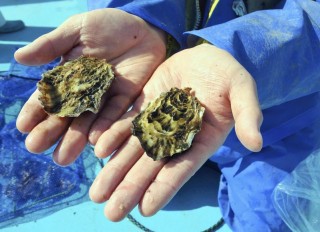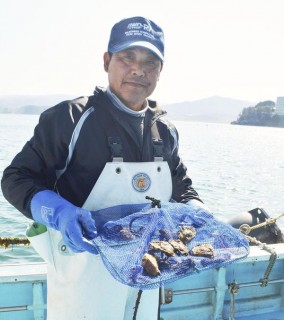Loading
Search
▼ Young Oysters Up-and-coming Sanriku Stars
- Category:Other
The Yomiuri Shimbun
MINAMI-SANRIKU, Miyagi — Farmers in Minami-Sanriku, Miyagi Prefecture, are cultivating rare unspawned oysters called Amakoro-gaki, aiming to sell them as the town’s brand oyster and thereby restore the oyster farming industry that was heavily damaged by the Great East Japan Earthquake.
Amakoro take less time to grow. They have not yet produced eggs and are sweeter than conventional oysters once they reach bite-size.
This is the first attempt to launch full-fledged sales of Amakoro, and shipping is scheduled to start in early June. The oyster farmers who volunteered to grow the rare variety are trying to establish a brand of Amakoro and increase distribution, in a bid to make the oysters a symbol of the town’s restoration and spur revitalization of the local economy.
“They’re growing well,” Shoki Sasaki, 57, said with a grin as he pulled baskets out of the water to check the size of the oysters inside.
Sasaki cultivates Amakoro in Shizugawa Bay. Construction is underway there to heighten embankments on the coast.
Miyagi Prefectural Kesennuma fisheries experimental station cast its eye on unspawned oysters in the hope of shortening the cultivation period and thereby revitalizing the industry quickly. The station encouraged oyster farmers in the town to cultivate the small oysters, and about 10 farmers began growing them in 2013.
Unlike the conventional method of putting seed oysters on a scallop-shell cultch and then waiting almost two years for them to grow, Amakoro seed oysters are scattered inside a basket and cultivated over six months to almost a year. They roll in the basket as they grow, forming round shells and meat.
Local people around the Sanriku coast call unshelled oysters “koro-kaki,” and the unspawned oysters grown with this method are named Amakoro-gaki because they are sweeter than standard oysters.
But there is a painful backdrop to the production of Amakoro. A decade ago, before the prefecture was hit by the massive earthquake, the production volume of oysters in Miyagi Prefecture was 4,165 tons of shelled oysters, but the tsunami destroyed almost all the farms.
Farming facilities are now almost entirely restored, but production remains low at 1,878 tons in 2014.
“Debris swamped the bay, and I thought it’d be impossible to get back into business,” said one of the members of the local fishermen’s cooperative.
Last year, the Deep Sea Water Oyster Center based in Toyama Prefecture cooperated with Sanriku farmers to sell Amakoro on a trial basis. The center said Amakoro received positive feedback when they were served at oyster bars in Tokyo.
“They’re small, but they have an attractive shape and they’re sweet,” one customer said.
The shipping season for Amakoro is different from that of oysters produced in Hiroshima and Fukuoka prefectures, giving the brand a business opportunity.
“
We’d like to advertise the ‘story’ of how Amakoro were born and produced,” the center’s spokesperson said.
Amakoro have been confirmed to taste good enough, and the task remaining now is how to mass-produce them. The Kesennuma experimental station and other groups involved are currently studying ways to improve productivity.
The shipping volume of Amakoro last year was 2,000 oysters. They expect to boost the volume for this year to 20,000.
“Our goal for next year is to ship 100,000 oysters. We’ll promote the oysters as a brand and also make them a symbol of the restoration of the earthquake,” the station’s spokesperson said.
Shiogama, Rikuzen-Takata also promote local oysters
SHIOGAMA, Miyagi — Similar efforts to restore oyster cultivation in a new style are also under way in other areas hit by the earthquake.
Efforts to promote Atamakko-kaki as a local brand oyster have been seen on far-flung islands in Shiogama, Miyagi Prefecture. The first full-scale shipments began from the middle of this month.
“Atama” means upper part. Farmers in the city grow oysters on netted shelves under the sea, and Atamakko are the ones placed on the top shelves.
Shells collide with each other as they are tossed by waves, and their outer shells remain small as they are crushed, allowing the oyster meat to grow fat. Those oysters also are exposed to a severe growing environment, such as being exposed to the air at low tide. Such conditions increase the umami of the oysters.
A farmer in Rikuzen-Takata, Iwate Prefecture, sells big oysters named Yukidoke-gaki by cultivating them longer — until early spring instead of winter — so they grow about 30 percent larger than normal.
Farming facilities are now almost entirely restored, but production remains low at 1,878 tons in 2014.
“Debris swamped the bay, and I thought it’d be impossible to get back into business,” said one of the members of the local fishermen’s cooperative.
Last year, the Deep Sea Water Oyster Center based in Toyama Prefecture cooperated with Sanriku farmers to sell Amakoro on a trial basis. The center said Amakoro received positive feedback when they were served at oyster bars in Tokyo.
“They’re small, but they have an attractive shape and they’re sweet,” one customer said.
The shipping season for Amakoro is different from that of oysters produced in Hiroshima and Fukuoka prefectures, giving the brand a business opportunity.
“
We’d like to advertise the ‘story’ of how Amakoro were born and produced,” the center’s spokesperson said.
Amakoro have been confirmed to taste good enough, and the task remaining now is how to mass-produce them. The Kesennuma experimental station and other groups involved are currently studying ways to improve productivity.
The shipping volume of Amakoro last year was 2,000 oysters. They expect to boost the volume for this year to 20,000.
“Our goal for next year is to ship 100,000 oysters. We’ll promote the oysters as a brand and also make them a symbol of the restoration of the earthquake,” the station’s spokesperson said.
Shiogama, Rikuzen-Takata also promote local oysters
SHIOGAMA, Miyagi — Similar efforts to restore oyster cultivation in a new style are also under way in other areas hit by the earthquake.
Efforts to promote Atamakko-kaki as a local brand oyster have been seen on far-flung islands in Shiogama, Miyagi Prefecture. The first full-scale shipments began from the middle of this month.
“Atama” means upper part. Farmers in the city grow oysters on netted shelves under the sea, and Atamakko are the ones placed on the top shelves.
Shells collide with each other as they are tossed by waves, and their outer shells remain small as they are crushed, allowing the oyster meat to grow fat. Those oysters also are exposed to a severe growing environment, such as being exposed to the air at low tide. Such conditions increase the umami of the oysters.
A farmer in Rikuzen-Takata, Iwate Prefecture, sells big oysters named Yukidoke-gaki by cultivating them longer — until early spring instead of winter — so they grow about 30 percent larger than normal.
- May 31, 2016
- Comment (0)
- Trackback(0)



